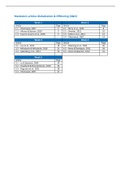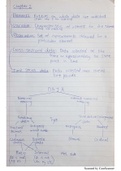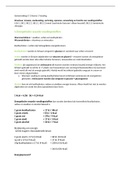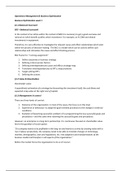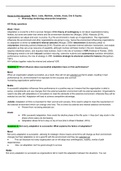Definitions
1) Genotype- an organisms genetic composition
2) Phenotype- an organisms physical characteristics and its interaction with the environment.
3) Locus- a specific location on a chromosome
4) Allele- an alternative form of a gene that occurs at the same locus on homologous
chromosomes
5) Haploid- a cell that contains a single set of chromosomes
6) Diploid- a cell that contains two copies of each chromosome
7) Heterozygous- two different alleles of a particular gene
8) Homozygous- having the same allele of a particular gene
9) Dominant- an allele that is expressed in the phenotype if only one allele is present in the
genotype
10) Recessive- an allele that is expressed in the phenotype if only two copies is present in the
genotype
11) Wildtype- the allele that encodes the phenotype that is most common in a natural
population
12) Mutant- an organism, gene or chromosome that is different from the wild type due to a
mutation
13) Self- fertilization (selfing)- when an organism is able to produce an offspring by itself, I.e.
plants
14) Cross fertilisation (cross)- fertilization in which the gametes are produced by separate
individuals or sometimes by individuals of different kinds
15) True breeding- when two organisms reproduce to produce genetically identical offspring
16) Pleiotropy- a pleiotropic gene is a gene that affect more than one phenotype
Genes are not always necessarily expressed in the phenotype. Loci are simply particular regions
on a chromosome. An allele is a genetic variant of a particular locus. A single locus can have
different alleles but only a maximum of two. Mutant allele refers to an allele that has been
changed from a common allele from a particular population. Sex cells are haploid and are
produced via meiosis. 'Adult' fungi are haploid. Two alleles- one from father and one from
mother- can be the same (homozygous) or different (heterozygous). Alleles can be homozygous
at one locus and heterozygous at another. Wildtype alleles have usually come about due to
evolution and it being the most advantageous to the organism.
Mendelian Genetics
Gregor Mendel from Czechoslovakia experimented on pea plants to explore genetics
(1822-1884). He was not fully appreciated until 1900. He published his first and second law in
1865.
• Mendel's 1st Law- The principle of segregation states the two members of a gene pair segregate
from each other in the formation of gametes. Gametes form when undergoing meiosis from
diploid cells.
• Mendel's 2nd Law- The principle of independent assortment states that members of different
gene pairs are transmitted independently of one another during gamete production. This is not
absolutely true because if to alleles are close together, they are likely to be inherited together.
Mendel observed seven traits within pea plants:
1. Flower (purple (D) /white) and seed coat colour (grey (D) /white).
2. Seed colour (yellow (D) /green)
3. Seed shape (smooth (D) /wrinkled)
4. Pod colour (yellow/green (D))
5. Pod shape (inflated (D) /pinched)
6. Stem height (tall (D) /short)
7. Flower height (axial (D) /terminal)
Genetics- BLGY1232 Page 1
,Mendel found there was no blending of traits, the progeny looked like one parents or the other.
P- refers to the generation used to produce offspring (parents)
F1- refers to the offspring/progeny generation (first filial- denoting the offspring of a cross)
F2- refers to progeny of the F1 generation (second filial)
3/4 of the F2 progeny had the dominant phenotype and ¼ had the recessive phenotype (ratio =
3:1)
In the crossing of smooth and wrinkled peas, true breeding smooth and true breeding wrinkled
were crossed over. When combining the gametes (S, S, s, s), all the offspring's are heterozygous
(Ss) and are all smooth wrinkled peas as this phenotype is dominant.
The first plant to have its whole genome sequenced was Arabidopsis thaliana. It was used
because it has a small genome (150,000,000 bp). Arabidopsis thaliana can contain a agamous
mutant phenotype. The mutation produces no sex organs (AGA = wild type gene, aga = mutant
gene).
Model organisms
• Arabidopsis thaliana was first plant to have its whole genome sequenced. It was used
because it has a small genome (150,000,000 bp). Arabidopsis thaliana can contain an
agamous mutant phenotype (recessive). The mutation produces no sex organs (AGA = wild
type gene, aga = mutant gene).
• Caenorhabditis elegans was the first animal to be sequenced (worm- like). It grows in
about 2 days so it a good model as it is relatively quick.
• Physcomitrella patens is a moss that is haploid so is easy to work with. It's small and easy
to grow.
• Mus musculus are mice have been used as experimental mammals for over 100 years. Zea
mays are corn crops that produce variants.
• Drosophila melanogaster are fruit flies. Growth development is usually studied using these
fruit flies. Eye colour is a trait observed too. Red eyes are the wild type and the mutation
produces white eyes. Another characteristic is normal wings and the mutant recessive
type is vestigial wings. Another mutation in flies is the antennae being replaced by legs.
This is due to mutation of a single gene causing misinterpretation of location of the allele
in the genome.
• Neurospora crassa, Saccharomyces cerevisae and Aspergillus nidulans are fungus that are
haploid that are usually used for experimentation.
Diploid cells undergo meiosis to produce haploid gametes but haploid organisms are unable to
undergo meiosis again as their genome cannot be cut in half again like in diploid cells. This is the
case for fungi. Fungi undergo a process where they produce spores in order to reproduce.
Genetics- BLGY1232 Page 2
,Lecture 2: Monohybrid crosses, test crosses and back crosses
Nomenclature:
• Gene names always written in italics
• Dominant alleles always written first and in capitals
• Recessive alleles are written in lower case
• Wildtype alleles are often denoted by '+'
• Different loci are defined by different letters to prevent confusion.
Loci can be referred to by three letters which are an abbreviation of the gene name. An example is
Antirrhinum majus (snap dragon)- the mutant produces no flowers but instead another flowering stem that doesn't produce
flowers. The floricaula gene is responsible for flower development and the floricaula mutant phenotype is recessive- (flo/flo).
The wild type phenotype is given by the following: FLO/FLO, FLO/flo, FLO/- .
Not all wild type alleles are recessive and some mutations can create dominant alleles.
• A+ and a+ - wild type allele that is either dominant or recessive
• A – mutant allele that is dominant to wild type
• A – mutant alleles that is recessive to wild type
Lethal alleles in mice
The agouti (brown) mice is the wild type and the yellow is the mutant. But the yellow mouse is dominant to the agouti
phenotype:
Wildtype genotype – y+/y+
Mutant genotype – Y/y+
Homozygous of the dominant gene is never found as yellow is a lethal gene and zygotes with both of Y alleles do not survive.
The yellow phenotype has pleiotropic effect (has multiple phenotypic effects). Coat colour is dominant trait but its lethality is
recessive. When we cross yellow mice together, we expect a 3:1 phenotypic ratio but the observed ratio is 2:1. This is due to
the lethal nature of the dominant Y allele. Homozygous dominant allele infers lethality upon the embryo. This is rare because
its dominant for colour but recessive for survival.
Mendel's 1st law: Principle of Segregation
The principle of segregation states two members of a gene pair segregate from each other in the formation of gametes. This
cross can be represented by a Punnett square. If a homozygous wrinkled seed and homozygous smooth seed was crossed
over (SS, ss), all possible zygotes would be heterozygous.
If the F1 generation was crossed over, the ratio of smooth to wrinkled seeds is 3:1 and the wrinkled seed phenotype
reappears. The genotype are SS, Ss and ss and the ratio is 1:2:1. There is no blending of traits, the progeny looks like one
Genetics- BLGY1232 Page 1
, reappears. The genotype are SS, Ss and ss and the ratio is 1:2:1. There is no blending of traits, the progeny looks like one
parent or the other. Looking at f2 generation tells us how many loci and alleles are present in the individual.
As well as punnet squares, branch diagrams are also used to determine frequencies of the ratio of dominant and recessive
genotypes.
Types of crosses
1) Monohybrid - parent organism differ with one characteristic
2) Dihybrid - parent organisms differ with two characteristics
3) Test cross - a cross done to determine if an organism with a dominant phenotype was a heterozygote or homozygote
4) Back cross - A cross between an individual and one of its parents
2) A test cross is done by determining the specific genotypes of F2 plants. F2 plants with smooth seeds are either SS or Ss.
Test crosses are done to determine which genotype it actually has. A test cross is crossing an individual of unknown genotype
and an individual with known genotype.
Codominance and incomplete dominance
Codominance is when both alleles are expressed together in the offspring
Incomplete dominance is blending of two alleles that results in a third phenotype that doesn't look like either of its parents.
An example of incomplete dominance is in Antirrhinum majus or snap dragon flowers. These flowers are either red or white
and both are homozygous for their phenotypes. All progenies will be heterozygous but they do not appear to be either red or
white but pink. They all have blended traits which goes against Mendel's law. In the F2 generation the ratio of white to pink
to red is 1:2:1. Heterozygous = pink and homozygous = white or pink. The heterozygote only produces enough pigment to
colour the flower pink not red which as a results produces a progeny with blended traits
Reproduction in Haploid organisms
Fungi are organisms with haploid genomes. Aspergillus mycelium has two ways to reproduce: Asexual reproduction via
spores and sexual reproduction via gametes. Vegetative spores called conidia is produced by mitosis in the
fungi. Conidia are a pigmented green colour and they grow to produce a colony. It also reproduces sexually using gametes
too. They are not produced by meiosis as they are already haploid. Their diploid zygotes are produced by mitosis instead.
Zygotes then undergo meiosis to produce ascospores which are haploid and these are sexual spores. They
all produce genetically identical spores. Several conidia colour mutants also exist which allows us to experiment with them.
Genetics- BLGY1232 Page 2


